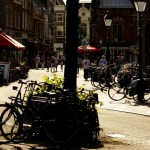Germany experiences faster growth than the world market
Frankfurt am Main / Berlin – Between January and December 2005, 48.2 million overnight stays by foreign visitors were recorded at hotels with nine or more beds and campsites in Germany, an increase of 6.4 per cent on 2004. „If we look at the travel figures, Germany saw a seven per cent increase in 2005, which was significantly above the figures recorded by our European neighbours and higher than the global trend of 5.5 per cent growth“, said Petra Hedorfer, Chief Executive Officer of the German National Tourist Board (GNTB), who is delighted with the upward trend in travel to Germany.
Since 1993, the number of overnight stays by international visitors in Germany has increased by around 14 million, or 45 per cent, and growth has been particularly dynamic since 2003. The GNTB is forecasting that, with further successful marketing and annual growth of around three per cent, there could be a total of 58 million overnight stays (an increase of 16 million) just in hotels with nine or more beds (excluding campsites) in 2015. A five per cent increase in the number of overnight stays by international visitors is expected for 2006. The 2006 FIFA World Cup™ will ensure that Germany exceeds the forecast global growth rate of three to four per cent.
German National Tourist Board
Today, visitors from abroad account for around one fifth of all overnight stays in Germany, half of all overnight stays in Frankfurt and one third of all overnight stays in Berlin. With receipts of Euro23.2 billion in 2005 and Euro25 billion forecast for 2006, the incoming travel sector is an important factor in the German economy.
Growth from all regional markets
In 2005, the German travel industry recorded growth from all relevant source markets. All 15 top markets recorded an increase between January and December 2005. Growth in the amount of travel to Germany from other European countries was particularly dynamic. In terms of the number of overnight stays, Germany recorded aboveaverage growth of 9.5 per cent, with particularly strong growth from south-west Europe. Spain has been a particular growth driver with an increase of 20.1 per cent, raising it from eleventh to tenth on the list of most important source markets for travel to Germany. Switzerland and Italy also recorded above-average growth, with increases of 10.2 per cent and 8.3 per cent respectively. The rise in incoming tourism from these markets as well as from other countries such as Austria (up 8.2 per cent), the UK (up 5.4 per cent) and, in particular, Ireland (up 20.2 per cent) has been given added impetus by changes to the transport infrastructure. The Netherlands is still the most important volume market for Incoming tourism to Germany with an increase of 5.1 per cent to more than 8.4 million overnight stays. A total of just under one million additional overnight stays in Germany were recorded by visitors from the three important source markets of Netherlands, Switzerland and Spain alone.
Increase in the number of overseas visitors
4.4 million overnight stays were recorded by visitors from the USA in 2005. This is the second-best result since 2000, which was a record year for the German tourism industry. Figures for the USA, the second most important volume market for incoming tourism, were up 2.4 per cent on 2004 – a particularly impressive result given the unfavourable exchange rate for Americans at present. We are already seeing a positive impact from the GNTB’s intensified marketing activities as part of its City Breaks/Events product line, which draws on the global mega-trend towards culture-related travel and the US American predilection for travel involving culture and sightseeing. US Americans put sightseeing (57 per cent), good food (37 per cent) and visiting places of historical interest (32 per cent) at the top of their list of things to do during a stay in Germany.
Demand for German destinations grows in the Middle East and Far East
GNTB Regional Management Asia/Australasia/South Africa has seen a 6.9 per cent increase in the number of overnight stays, with particularly high growth from the Arab Gulf States. Between January and December 2005, the source market recorded a 26.7 per cent increase on the previous year to 649,000 overnight stays. This was the highest growth rate shown by any market for incoming travel to Germany in 2005. Once again, the Arab Gulf States moved up one place in the ranking of source markets in 2005. The establishment of the 29th GNTB sales and marketing agency in Dubai, in collaboration with Lufthansa, in January 2005 has provided fresh impetus for growth here. The number of flights offered has also been considerably expanded, helping to increase the figures for incoming tourism to Germany from the whole region.
South Korea recorded an encouraging 8.8 per cent increase and, while not as dynamic as in the previous year, we still saw continued growth from China with an eight per cent increase, Japan, the most important Asian market for incoming tourism to Germany, only recorded a slight increase of 2.1 per cent. However, the „Germany in Japan 2005/2006“ campaign and the 2006 FIFA World Cup™ are expected to have a positive impact in 2006.
City breaks in Germany are growing in popularity
City breaks were particularly popular with international visitors to Germany in 2005. The city break segment recorded a 15 per cent increase from Europe alone, most of which can be attributed to new low-fare deals. Out of all the members of the Magic Cities Germany marketing association, Hannover recorded the highest growth in 2005. The number of overnight stays by visitors from abroad increased by 27.2 per cent. In addition to its growing importance as a premier international trade fair centre, Hannover also benefited from hosting the Confederations Cup in June 2005. Other cities recording above-average growth included Berlin with a 19 per cent increase in the number of overnight stays – up 800,000, Dresden with a 14 per cent increase, Cologne with a nine per cent increase and Munich with an eight per cent increase. These figures are testament to the success of the people working in the German travel industry and the attractiveness of Germany as a travel destination for visitors and tour operators.
Excluding the city states, Lower Saxony was the federal state that gained most from the growth in the incoming sector, with a 12.7 per cent increase compared with the previous year. The two largest destination markets combined, Bavaria and North Rhine- Westphalia, recorded around one million more overnight stays by foreign visitors.
Germany’s recognised health and spa resorts also experienced a considerable increase in the number of overnight stays. Spa resorts and seaside spas recorded 7.7 per cent and 12.8 per cent more overnight stays by foreign visitors respectively.
Growth in the German incoming market boosts the hotel industry
International visitors are one of the main cornerstones for the hotel industry. The number of overnight stays by international visitors increased by 6.1 per cent on 2004 to around 39 million. Around 80 per cent of the approximately 48 million overnight stays booked in 2005 by international visitors to Germany were in hotels, bed & breakfast hotels, inns and guesthouses. This also reflects the significance of the business travel segment. Germany has already increased its market share of the international conference sector by two percentage points from Europe alone in the run up to the 2006 FIFA World Cup™, consolidating its position as the leading destination in the world for trade fairs and the second most popular destination for congresses and conferences. Youth hostels also saw a 19.9 per cent increase in the number of overnight stays by foreign visitors in 2005. This high level of growth is the result of extensive modernisation and development work carried out to meet growing demands in the low-cost travel sector. The demand for stays at campsites increased by 0.8 per cent.





